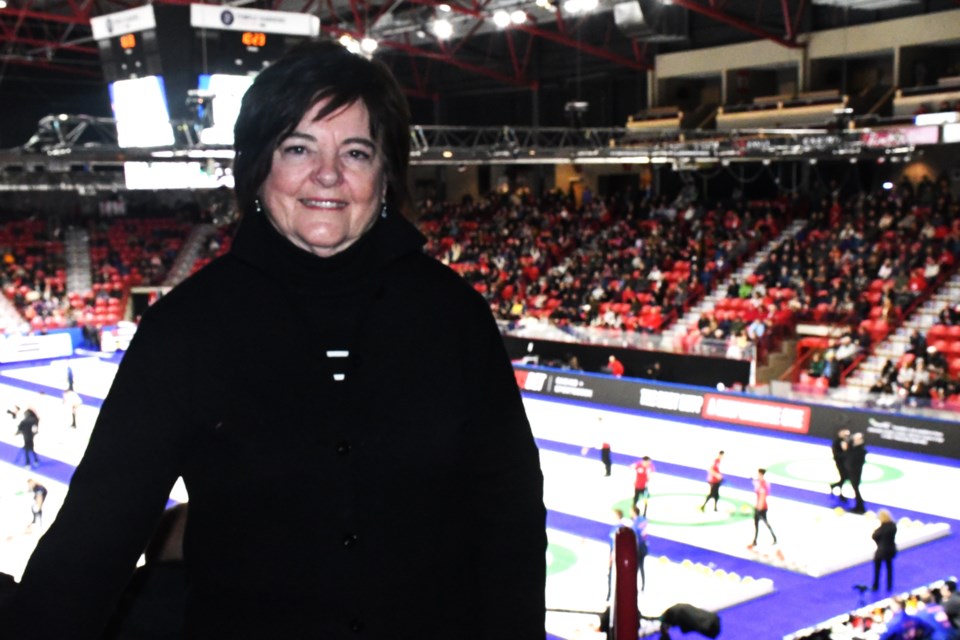MOOSE JAW — It’s been 55 years since Dorenda Stirton and her curling team became the youngest group ever to compete in — and win — a national championship, something she still fondly remembers.
Based then out of Saskatoon’s Nutana Curling Club, Stirton — who went by the then-last name of Schoenhals, as she had just married — skipped the 1970 Ladies Canadian Curling Championship team that included her sister, Cheryl (Stirton) Zipper as third, Linda (Burnham) Seaman as second and Joan Anderson as lead.
The foursome was the youngest team ever to compete in that tournament — now known as the Scotties — although they had already won five consecutive Western Canadian University Championship titles from 1964 to 1969.
The skip also won two curling championships in high school in the early 1960s.
— in which the Nutana foursome was installed on June 17, 1989 — the Schoenhals-skipped team had a remarkable competitive season in 1970 with a record of 23-3.
During the Ladies Canadian Curling Championship, the team finished in a three-way tie for first place with a 10-2 record. It had to defeat the other tie-holder teams of Manitoba and British Columbia to claim gold.
“The thing I think we’re all most proud of is that we probably were, and will always be, the youngest team ever (to win a national title). Because right now, they play in the juniors until they’re 21,” Stirton told the Moose Jaw Express/MooseJawToday.com at the Temple Gardens Centre during a break from watching the 2025 BKT World Men’s Curling Championship.
The 1970 team
The Central Collegiate graduate, now 77, said she was , while her teammates were 19, 20 and 21. She noted that while curling legend Colleen Jones won her first major title at 22, the Nutana team is still the youngest winning national team.
Stirton’s team, under coach Roy Thiessen, was the first to introduce exercises and sliding as warm-up activities at a national championship. This was new and left spectators and curlers in awe at a routine that is now commonplace.
“Nobody did that back then. Nobody. You just (went) out to the ice, you shake hands, you get in, and you throw,” she said. “There was no practice, no nothing. And half the time, I don’t know how we didn’t injure ourselves … .
“We were criticized for (the warm-ups). One of the ladies at the club said it was unladylike to have that long slide,” Stirton continued, adding they slid out to the hog line when delivering their rocks, which was also unusual then. “Yeah, (curling’s) come a long way.”
A great coach
Stirton credited Thiessen with helping the team excel since he ensured they were limbered up beforehand, which gave them an advantage over other teams.
Thiessen was one of the first coaches — a pioneer — to study the game and write books about it from a technical perspective, while teams became better because they received more coaching and instruction, she added.
Stirton’s other curling career highlights include competing in the senior women’s (over age 50) and the master’s women’s (over 60), and
Growing up in Moose Jaw
Reflecting on the past, Stirton said Moose Jaw had amazing girls’ and boys’ curling teams in the 1960s and 1970s, with the Central boys’ team competing in the Canadian Schoolboy Championships annually, while the girls’ teams were limited to provincial championships.
The former Moose Javian — she now lives in Vancouver — noted that she reconnected with many Central curlers at the Temple Gardens Centre and held a fun mini high school reunion.
Meanwhile, Stirton said she “was lucky” because she lived on Oxford Street and the curling rink was two blocks away on Caribou Street, which enabled her to practice daily. She also credited Thiessen with making her better since he taught her to properly throw the rock.
The young woman grew up on a farm 12 miles outside of Moose Jaw and didn’t have access to a gymnasium. However, her dad curled, so she thought it was something she could do.
“So I remember those days, walking home (and) back and forth to the rink after school every day,” she chuckled.
A serious game
While curling was more of an amateur sport decades ago, today it has become an elite — and much more serious — sport, especially after it reached the Olympics, Stirton said. Therefore, curlers who compete recreationally several nights a week will not likely reach the Brier or Scotties unless they train extensively.
There are many stories of teams that attended bonspiels, stayed out late to drink, and woke up early to compete, she continued. That still happens — “it’s the fun part of curling” — since many teams meet in the lounge afterwards and buy each other drinks out of respect.
“It’s still got that camaraderie. It’s still got that really good feel to it … ,” Stirton stated.
However, many serious teams have made curling their life, cleaned up their habits, and acquired sponsors because the sport has become expensive.
“I think the calibre of the game has really gone up, and I think when they put microphones on the players, the general public got a lot more out of watching (games) on TV … ,” Stirton said. “That’s what makes curling interesting to people, is the strategy.”
Stirton added that she is grateful to have grown up in Moose Jaw and still considers herself a Saskatchewanian and a Westerner, is proud that she was a pioneer for women’s curling, and is pleased to give back by coaching and volunteering.




